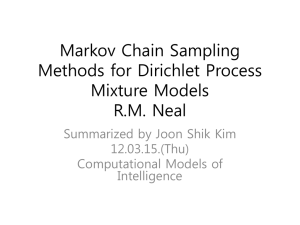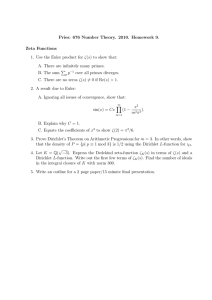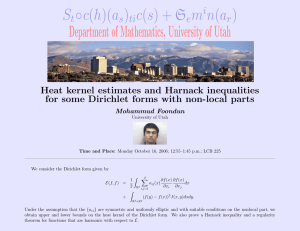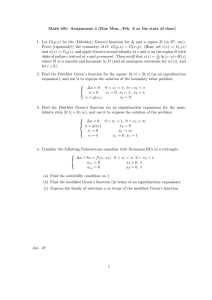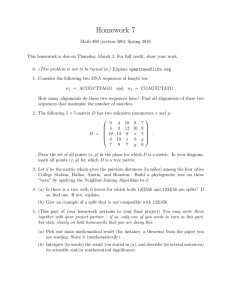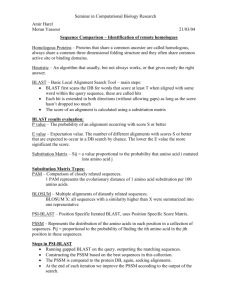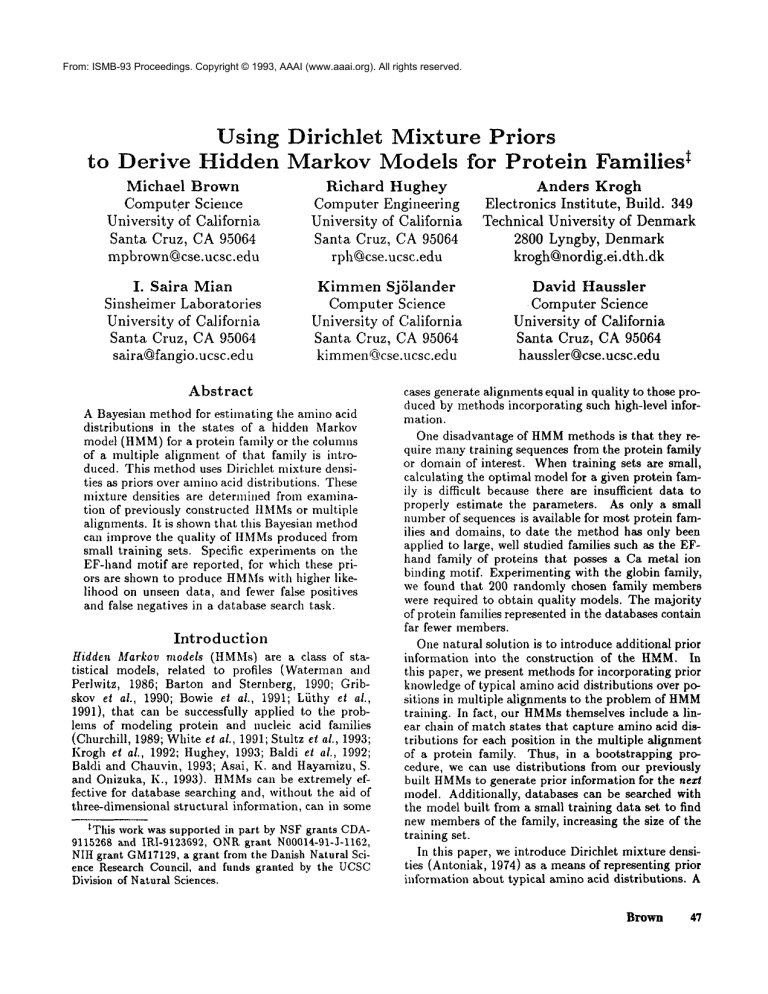
From: ISMB-93 Proceedings. Copyright © 1993, AAAI (www.aaai.org). All rights reserved.
$to Derive
Using Dirichlet
Mixture Priors
Hidden Markov Models for Protein
Families
Michael Brown
Comput.erScience
University of California
Santa Cruz, CA 95064
mpbrown~cse.ucsc.edu
Richard Hughey
ComputerEngineering
University of California
Santa Cruz, CA95064
rph~cse.ucsc.edu
Anders Krogh
Electronics Institute, Build. 349
Technical University of Denmark
2800 Lyngby, Denmark
krogh~nordig.ei.dth.dk
I. Saira Mian
Sinsheimer Laboratories
University of California
Santa Cruz, CA 95064
saira@fangio.ucsc.edu
Kimmen SjSlander
Computer Science
Universityof C, alifornia
Santa Cruz, CA95064
kimmenC@cse.ucsc.edu
David Haussler
¯ ComputerScience
University of California
Santa Cruz, CA95064
haussler@cse.ucsc.edu
Abstract
A Bayesian method for estimating the amino acid
distributions
in the states of a hidden Markov
model (HMM)for a protein family or the colunms
of a multiple alignment of that family is introduced. This method uses Dirichlet mixture densities as priors over amino acid distributions. These
mixture densities are determined from examination of previously constructed tlMMs or multiple
alignments. It is shownthat this Bayesian method
can improve the quality of ItMMsproduced from
small training sets. Specific experiments on the
EF-hand motif are reported, for which these priors are shown to produce HMMs
with higher likelihood on unseen data, and fewer fal~ positives
and false negatives in a database search task.
Introduction
Hidden Markov models (HMMs)are a class of statistical
models, related to profiles (Waterman and
Perlwitz, 1986; Barton and Sternberg, 1990; Gribskov et al., 1990; Bowie et al., 1991; Li]thy et al.,
1991), that can be successfully applied to the problems of modeling protein and nucleic acid families
(Churchill, 1989; White el al., 1991; Stultz el al., 1993;
Krogh et al., 1992; Hughey, 1993; Baldi el al., 1992;
Baldi and Chauvin, 1993; Asai, K. and Hayamizu, S.
and Onizuka, K., 1993). HMMscan be extremely effective for database searching and, without the aid of
three-dimensional structural information, can in some
tThis work was supported in part by NSFgrants CDA9115268 and IR1-9123692, ONRgrant N00O14-91-J-1162,
NIHgrant GM17129,a grant from the Danish Natural Science Research Council, and funds granted by the UCSC
Division of Natural Sciences.
cases generate alignments equal in quality to those produced by methods incorporating such high-level information.
One disadvantage of HMM
methods is that they require manytraining sequences from the protein family
or domain of interest. Whentraining sets are small,
calculating the optimal model for a given protein family is difficult because there are insufficient data to
properly estimate the parameters. As only a small
number of sequences is available for most protein families and domains, to date the method has only been
applied to large, well studied families such as the EFhand family of proteins that posses a Ca metal ion
binding motif. Experimenting with the globin family,
we found that 200 randomly chosen family members
were required to obtain quality models. The majority
of protein families represented in the databases contain
far fewer members.
One natural solution is to introduce additional prior
information into the construction of the HMM.In
this paper, we present methodsfor incorporating prior
knowledgeof typical amino acid distributions over positions in nmltiple alignments to the problem of HMM
training. In fact, our HMMs
themselves include a linear chain of match states that capture amino acid distributions for each position in the multiple alignment
of a protein family. Thus, in a bootstrapping procedure, we can use distributions from our previously
built HMMs
to generate prior information for the next
model. Additionally, databases can be searched with
the model built from a small training data set to find
new membersof the family, increasing the size of the
training set.
In this paper, we introduce Dirichlet mixture densities (Antoniak, 1974) as a means of representing prior
information about typical amino acid distributions. A
Brown
47
related use of mixture priors, in this case Gaussian mixture priors used in the context of neural net training,
was given in (Nowlan and Hinton, 1992). The Dirichlet mixtures cluster amino acid distributions into prototypicai classes of distributions. Using Bayes’ rule,
Dirichlet mixture densities can be combined with observed frequencies of amino acids to obtain posterior
estimates of aminoacid distributions. Ill a detailed set
of experiments on building HMM
models of the EFhand motif, we showthat such posterior estimates lead
to superior HMMs.In particular,
we show that HMMs
for the EF-hand motif trained using appropriate priors produce models that have higher likelihood with
respect to independent (non-training) sets of EF-hand
motifs. Furthermore, we show that these models produce fewer false positive and false negative sequences
when searching a database.
Our present work has several conceptual similarities
with profile methods, particularly in regard to seeking
meaningful or prototypical amino acid distributions for
use in database search and multiple alignment (Waterman and Perlwitz, 1986; Barton and Sternberg, 1990;
Gribskovel al., 1990; Bowieel al., 1991; Lfithy et al.,
1991). In particular,
Liithy, McLachlan and Eisenberg (1991) have analyzed multiple alignments using
secondary structure information to construct a set of
distributions describing the columnarstatistics of secoudary protein structures. The result of their work is a
set of nine probability distributions, whichwe will call
the LMEdistributions, describing the distribution of
aminoacids in nine different structural environments in
a protein. 1 These LMEdistributions have been shown
to increase the accuracy of profiles in both database
search and multiple alignment by enabling them to
take advantage of prior knowledgeof secondary structure.
There are two difficulties in applying the LMEdistributions to HMMs.First, there is no measure of
howmuch variance is associated with each of the distributions. This is important because Bayes rule demands that in computing the posterior, the observed
frequency counts be modified less strongly when the
prior distribution has a very high variance. Second,
the LMEdistributions are directly associated with secondary structure,
whereas we assume no secondary
structure information is available.
Instead of beginning with secondary structure, our
approach is to use unlabeled training sequences to discover, through clustering, those classes of distributions
of amino acids that are intrinsic to the data. Wedo
this with statistical methodsthat directly estimate the
most likely Dirichlet mixture density from observed
counts of amino acids. In several cases, the amino acid
distributions we find are easily identified as typifying
some commonlyfound distribution (e.g., a large nonpolar), but we do not set out a priori to find distribu1In more recent work, they have used 18 different distributions (Bowieet al., 1991).
ISMB-93
tions representing these structures.
For a review of the essentials of the HMM
methodology we use, including architecture, parameter estimation, multiple alignments, and database searches, see
(Krogh et al., 1992).
Modeling amino acid distributions
Dirichlet mixtures
with
Examiningthe columns in a large multiple alignment of
a homologousset of protein sequences, we see a variety
of distributions of amino acids. In the extreme case,
when an anaino acid is highly conserved at a certain
position in the protein family, such as the proximal
histidine that coordinates the hemeiron in hemoglobin,
the distribution of amino acids in the corresponding
column of the multiple alignment is sharply peaked
on that one amino acid, whereas in other cases the
distribution is spread over manypossible amino acids.
There are many different commonlyoccurring dis~
tributions. Someof these reflect preference for hydrophobic amino acids, some for small amino acids,
and some for more complex combinations of physicochemical features. Using a purely statistical
method,
we have attempted to discover and model the major
types of amino acid distributions found in columns of
multiple alignments. Our principle intent was to use
this iuformation to produce better multiple alignments,
but the results may also be of independent biological
interest.
Our primary data is a set of N count vectors. Each
count vector in this set represents data from a specific column in a specific multiple alignment. Many
multiple alignments of different protein families are included, so N is typically in the thousands. Let us
suppose that we fix a numbering of the amino acids
from I to 20. Then, each count vector has the form
ff -- (ni .... , n20), whereni is the numberof times the
i th amino acids occurs in the column represented by
this count vector. Wemake the simplifying assumption that the amino acids in a particular column are
geuerated independently at random according to an
underlying probability distribution fi = (Pl ..... P20)
over the 20 anaino acids. Each column, however, is assumedto have its ownunique probability distribution.
Our goal is to model the kinds of distributions/7 that
are most likely generating the actual observed count
vectors.
A trivial approach would be to estimate a probability distribution /Y separately for each count vector or
column. Under our independence assumption, a single
couut vector ~ is interpreted as data from a multinomia] distribution with unknownparameters ]. Wecan
estimate the Pi parameters from this data using the
usual lnaximumlikelihood method, i.e. by finding the
pi’s that maximize
, . . . , p2o).
Proh(n~
.... , n~olp~
As is well known, this leads to the obvious estimate
2O
Pi "- nl/n, where n - ~i=I
nl. These i6i values are just
a summary of the raw data, and for small n provide
only poor estimates for the actual underlying probability distributions.
To solve this problem, we propose a two-stage
stochastic model for the data. Weassume that, for
each count vector if, first a distribution ff is chosen
independently from an unknownprobability density p
over all such distributions,
then the count vector
is generated according to the multinomial distribution
with parameters ft. Our goal is now to bypass the
estimation of the individual 17 parameter vectors and
instead use the data from the count vectors to directly
estimate the underlying density p.
To make this feasible, we have assumed a simple
parametric form for the density p, initially choosing a Dirichlet density with unknown parameters
al,...,a~0
(Berger, 19851 Santner and Duffy, 1989).
The value of p at a particular point 17 is given by:
p(p-.)
lr-lr 20 <~,--1
ll i=l Pi
(1)
’
Z
where Z is the normalizing constant such that p integrates to unity. Letting a = ~"~=1a’i, it is easy to see
that the Dirichlet density with parameters cq,..., o~20
is peaked around the amino acid distribution where
Pi = Oti/ot. The larger c~ is, the more peakedis the density. Thus, modelingp by a simple Dirichlet density assumes that all amino acid distributions are deviations
from one central underlying anaino acid distribution.
Because this latter assumption seems dubious, in
further experinaents we have used a more complex form
for the density p. In particular, we assume that p has
the form
p = qlPi + ... + qkP~,
(2)
where each Pi is a Dirichlet density and the numbers
ql,.-.,qk
are positive and sum to one. A density of
this form is called a mixture density (or, in this specific case, a Dirichlet mixture density), and the qj values are called mixture coefficients. Each of the densities pj is called a component of the mixture. By using a Dirichlet mixture, we hope to discover several
underlying "prototypical" amino acid distributions: a
collection of amino acid distributions such that each
observed column count from a multiple alignment is
very likely obtained from a minor variant of one of the
prototypes. The process is similar to clustering amino
acid distributions into types. However,instead of having just 20 parameters cq,..., a.~0 to estimate, as in tim
case of a single Dirichlet density, we now have 21 x k
parameters to estimate: twenty oq values for each of
the k components of the mixture and twenty mixture
coefficients. This is feasible if k small and the number
of count vectors available is large.
We have used the maximum likelihood method to
estimate the parameters of p from the set of count vectors. Thus, we searched for the parameters of p that
would maximize the probability of occurence of the
observed count vectors. In the simplest case, we have
simply fixed the number of components k to a particular value and then estimated the 21 x k parameters.
In other experiments, we tried to estimate k as well.
Unfortunately, even for fixed k, there does not appear
to be an efficient method of estimating these parameters that is guaranteed to always find the maximum
likelihood estimate. However, the standard estimationmaximization (EM) algorithm for mixture density es2timation works well in practice.
The final result of this statistical estimation is a
set of k mixture coefficients, ql,...,qk,
and a set of
k Dirichlet parameter vectors, ~l,...,~k, where ~j is
the vector a~j),. .., a~#0) of parametersof the flh Dirichlet component in the mixture. These parameters are
possibly interesting in themselves, in terms of what
they reveal about protein structure (as discussed in
the next section), however their main use will be in
improving multiple alignments and other models derived from multiple alignments, such as profiles and
HMMs.
Consider the production of a multiple alignment for
a protein family. From one column in a rough, initial
alignment, a count vector ~ is obtained. One immediate question to consider is whether or not the count
vector is similar to one of the distributions on amino
acids tlmt commonlyoccurs in protein families. If this
is the case, then this can be considered evidence for
the accuracy of the alignment (otherwise, it may be
considered evidence against that particular alignment).
Furthermore, assuming a correspondence, one may ask
what structural role is usually played by positions that
have this kind of distribution and use this information
to discover the commonstructure of the proteins family. Finally, if only a relatively small numberof proteins make up the alignment (less than 30), then one
does not expect the counts ~ to yield good estimates of
the actual probabilities/7 that each aminoacid will appear in that position in other proteins from the family
not yet included in the alignment. Thus, it is difficult
to use this alignment to search a database for other
proteins in the family, by profile, HMM,
or alternative
methods. By combining these counts with prior information from the Dirichlet densities, better estimates
of the pl parameters can be obtained. In this sense
the Dirichlet mixture prior provides an alternative to
the use of the Dayhoff matrix (Dayhoff el al., 1978),
and other means of "smoothing" probability estimates
based on a few occurrences of amino acids.
Once we have estimated the parameters of a Dirichlet mixture, these issues can all be addressed in a
purely statistical
manner. Wedo this by treating the
2Anintroduction to this methodof mixture density estimation is given in the book by Duda and Hart (1973).
Wehave modified their procedure to estimate a mixture
of Dirichlet rather than Gaussian densities. The mathematical details of this will be described in a separate paper
(Brownet al., 1993).
Brown
49
Dirichlet mixture density p as a prior probability density over the possible actual distributions/Y in the new
protein family being modeled. Then, given the actual counts ff for a particular column of a multiple
alignment, we can use a Bayesian method to determine tile type of distribution that mayhave generated
these counts, (i.e., which of the k compouents of the
Diriclflet mixture may have produced the underlying
probability distribution/Yfor this position) and to produce estimates/~1 ..... /~20 of the actual Pi values. The
latter estimates will differ from the maximum
likelihood estimates, and should be much better when n is
small.
It is straightforward to derive the formulas for these
Bayes estinaates, assuming a Dirichlet mixture prior
(Brownet al., 1993). In the first case, for each j between 1 and k, we want to calculate Prob(jla ), the
posterior probability that the uuderlying probability
distribution /Y that produced the observed counts
was chosen from the jth component of the Dirichlet
mixture. Hence, instead of identifying one single component of the mixture that accounts for the observed
data, we determine how likely each individual component is to have produced the data. Using Bayes rule,
qj Prob(fflpj
Pr°b(JlrT) = E~=I qtPr°b(fflPt)"
(3)
~0 ni and a’J)=
And, if n = E;=I
Prob(~[pj)
(j)
E~O10~ i ,
r(n + 1)r(~(~)) ~-~ r(m + a(/))
F(n. + a’(’/I)/’]’~1
F(ni 1)F(allJ))’
where F(x) is the gammafnnctio,~. Ilence this gives
an explicit formula for the first kind of estimate.
For the second kind of estimate, the estimate of the
pi parameters from the counts rli, again using Bayes
s,
rule
k Prob(j[ff)alj)
ni + )-’~4=1
,
(4)
Pi =
Z
where Z is the appropriate normalizing constant so
20 .that ~=t Pi = 1.
Wepropose this method as a new way of interpreting
count data from multiple alignments. In particular, we
suggest that a comprehensive Dirichlet mixture density
be constructed that covers most of the anfino acid distributions that have been found in existing nmltiple
alignments. Then, when new multiple alignments are
constructed, we suggest that the statistics from each
column be used to classify that column based on the
posterior probabilities of the componentsof the Dirichlet mixture, using Equation 3, and that the underlying
probabilities of the 20 amino acids for that columnbe
estimated using Equation 4. In the following section
we describe the experiments we have done using this
method.
3This is actually
rameters/~.
50
ISMB-93
the mean posterior
estimate
of the pa-
Sequences
Columnsin Alignment
400
193
88
147
254
401
Protein Family
Globins
Kinases
Elongation
Figure 2: Protein families included in the HMM
data
set.
Results
Obtaining
Priors
As described above, our approach focuses on an automated construction of priors based on multiple alignmeats. Here we describe the construction of several
Dirichlet mixture priors and demonstrate the effectiveness of these priors in building accurate models for the
EF-hand motif.
Weused two sources of multiple alignments for our
raw count data: alignments from the HSSPdatabase
(Sander and Schneider, 1991) (Figure 1), and multiple
alignments we generated using HMMs
to model the kinasa, globin and elongation factor families (Haussler
el al., 1993; Krogh et al., 1992) (Figure 2). The
tal number of columns from the HSSPalignments was
5670; the number of columns from the HMMalignmcnts totaled 802.
The HSSPdatabase contains multiple alignments
of proteins obtained by taking a single protein whose
three dimensional structure is known, and aligning to
it. other proteins that are deemed homologous above
a certain threshold to this protein but whose structure is not known. In (Sander and Schneider, 1991),
representative set of HSSPmultiple alignments is suggested that includes a variety of different protein types.
Weused all the multiple alignments in this representative set with 30 or more sequences to obtain our HSSP
count data. These proteins are listed in Figure 1.
Sequences used to create HMM
alignments were obtained from various sources. The training data we used
to create our kinase alignment came from the March
1992 release of the protein kinase catalytic domain
database maintained by S. K. Hanks and A. M. Quinn
(1991). This set is biased towards sequences from
vertebrates and higher eucaryotes but includes some
from lower eucaryotes. There are only two kinases encoded by viral genomes. Training data for the globin
alignment consisted of all $1obins from the SWISSPROTdatabase, release 22 (Barioch and Boeckmann,
1991). Elongation factor sequences were drawn from
the SWISS-PROT
database, releases 22 and 23. Multiple alignments for these sequences were produced
by HMMs
we built for these families, as described in
(Krogh et al., 1992; Hughey, 1993). Summaryinformation for these data sets is given in Figure 2.
Using the maximumlikelihood procedure described
in the previous section, we estimated the parameters
of both a one component Dirichlet mixture density and
J Sequences
948
475
372
287
251
242
191
178
130
126
I09
107
102
89
89
89
82
81
77
71
65
63
63
6O
59
54
53
49
46
46
41
39
38
38
36
35
.33
31
31
30
30
HSSPidentifier
1HDS
IFDL
2FBJ
2PKA
7ADH
ITRC
2TGP
ITGS
3HLA
2RUS
3CYT
4INS
5P2P
1R08
2RRI
2RS3
3SGB
ICDT
2MEV
1NXB
2LTN
IGDI
IWSY
IFC2
1FC1
IETU
8RSA
5HVP
4LYZ
9API
2CD4
IGCR
2SBT
2SOD
ICSE
9WGA
31CB
1CMS
5LDH
1MHU
2MRT
Protein F,mily
HEMOGLOBIN
IG=GI FAB FRAGMENT
IG"A FAB FRAGMENT
KALLIKREIN A
ISONICOTINIMIDYLATED
LIVER ALCOHOL DEHYDROGENASE
CALMODULIN
TRYPSINOGEN COMPLEX WITH PANCREATIC TRYPSIN INHIBITOR
TRYPSINOGEN COMPLEX WITH PORCINE PANCREATIC SECRETORY
HUMAN CLASS I HISTOCOMPATIBILITY ANTIGEN A2.1
RUBISCO
CYTOCHROME $C
INSULIN
PHOSPHOLIPASE A=2
RHINOVIRUS 14
RHINOVIRUS 14
RHINOVIRUS 14
PROTEINASE B FROM STREPTOMYCES
GRISEUS
CARDIOTOXIN V=4===/II$==
MENGO ENCEPHALOMYOCARDITIS
VIRUS COAT PROTEIN
NEUROTOXIN $B
PEA LECTIN
HOLO-=D-*GLYCERALDEHYDE-3-PHOSPHATE
DEHYDROGENASE
TRYPTOPHAN
SYNTHASE
IMMUNOGLOBULIN
FC AND FRAGMENT B OF PROTEIN A COMPLEX
FC1 FC FRAGMENT
ELONGATION FACTOR TU
RIBONUCLEASE *A
HIV$-I PROTEASE COMPLEX WITH ACETYL-PEPSTATIN
LYSOZYME
MODIFIED ALPHA=I =-*ANTITRYPSIN
CD45
GAMMA-/n$ CRYSTALLIN
SUBTILISIN NOVO
CU,ZN SUPEROXIDE DISMUTASE
SUBTILISIN CARLSBERG
WHEAT GERM AGGLUTININ
CALCIUM-BINDING PROTEIN
CHYMOSIN B
LACTATE DEHYDROGENASE
H=4= AND S-$LAC./NAD$=m+==
COMPLEX
CD.7 METALLOTHIONEIN-2
CD.7 METALLOTHIONEIN-2
Figure 1: Protein families iucluded in the HSSPdata set.
a nine component Dirichlet mixture density from the
5670 count vectors obtained from the I’ISSP multiple
alignments. Wecall these Dirichlet mixtures HSSP1
and HSSP9, respectively. As Blentioned in the previous section, the EMmethod we use is not guaranteed
to always find the optimal setting of the parameters.
However, nmltiple runs of the program with different
initial parameter settings, yielded virtually identical
priors, indicating that these solutions are very stable.
In addition, we conducted all experiment to find a prior
with a larger number of components. For this experiment, we started with 100 components using random
initial values for the DiricMet parameters. After eliminating those components found to not represent any
of the data, we obtained a mixture prior having 62
components, which we call HSSP62.
Similar experiments were done for the HMM
alignments, obtaining Dirichlet mixture priors with one
component, nine components, and 33 components
(tIMM1, HMM9,HMM33).The results for the singlecomponent and nine-component priors were also shown
to be stable with respect to the initial starting point
of the estimation procedure.
We studied the priors we obtained from the IIMM
alignments and the HSSPalignments and found several components cominon to both sets. Similarity between components was determined by Kullback-Leibler
distance and by examination of the physieo-chemical
attributes of the distributions. The a parameters of
the HMM1
and HMM9
priors are given in Figure 3.
The distributions and physico-chemical attributes of
the componentsof these priors are summarizedin Figures 4 and 5.
In general, the physico-chemical attributes of the
components of the HMM9
prior are consistent with
biological intuition. Whenwe order the components
with respect to their mixture coefficients (i.e., their
probabilities),
the first component, HMM9.1,contains mostly small residues. The second component,
HMM9.2,is large, charged and polar. HMM9.3
is polar, and has mostly negatively charged residues, except for Aianine (A), which is small, neutral, and can
be found in virtually every environment. HMM9.4
has a weak tendency towards hydrophobic residues
and contains three large non-polar residues, Isoleucine
(I), Leucine (L), and Valine (V) with high probability. However,it also contains a single chargedresidue,
Lysine (K) with high probability, but it is worth noting that Lysine possesses a long hydrophobic carbon
chain in addition to the positively charged nitrogen
atom. HMM9.5
is strongly hydrophobic and contains
uncharged, nonpolar amino acids. HMM9.6
is charged,
hydrophilic and polar, and HMM9.7
is negatively
charged and aromatic. HMM9.8
is strongly hydrophoBrown
51
J’[]dM
1 a.,,,4.n
HMMg.1
H2~ g.l 0-3.0
lUd]/8.2 ~-5.4
I-IMMg.2
HMMg.3
Hfd]d 0.$ a-g,?
HMM~4
LDdid0.4 ,a-14,1
ItM~i 11.5 a-?,~
H~g.6 ,a=2g.~,
I~lM g.7 a-0.86
FLMM9,8 1-11.O
HLrw a.g a-8.6
Figure 3: a parameters for the HMM1and tlMM9
priors. These bar charts show the 20 t~i parameters of
tile Dirichlet density of HMM1
and of each of the nine
components of HMM9.The ordering of the residues
used is that proposed by Taylor (1986). Starting from
the left, the amino acids form four groups: small and
polar, large and polar, large and non-polar, and small
and non-polar. Each bar chart is scaled by the largest
ai. The parameter a is the sum of the ai, which gives
some idea of the real magnitude of the parameters.
HMMg.7
HMMO.S
HMMg.8
HMIVl9,g
Figure 4: Log ratios for the distributions represented
by the ItMM1 and HMM9priors. The i th bar in the
graph for HMM9.jshows the logarithm of the ratio
pi/qi where Pi is the probability of the i th amino acid
in the mean of the jch component of the HMM9
prior.
The variable, qi, is the probability of the i th amino
acid in the overall mean of HMM1.
These values represent the difference in mean amino acid distribution
of the jth component from the background distribution. Positive numbers indicate higher values than the
background distribution;
negative numbers represent
lower values than the background.
bic, non-polar and uncharged. HMM9.9greatly emphasizes large residues aswell as aromatic, hydrophobic
and uncharged residues.
In addition to the priors we obtained via maximumlikelihood estimation, we tested the effectivehess of some additional priors: the standard uniform
prior called Add One, 4 priors obtained directly fi’om
the nine-component LMEdistributions (Liithy et al.,
1991) and a 29-component EF-hand custom prior in
which each component is derived from a column in our
EF-hand multiple alignment. The prior derived from
the nine-component LMEdistributions
was obtained
by forming Dirichlet mixture components for each of
the nine LMEamino acid distributions with the same
means and a fixed variance. 5 The 29-component EF-
hand custom prior was designed specifically as a kind
of control for the EF-hand motif experiments reported
in the next section. Each component of this mixture
is a Dirichlet distribution that is strongly peaked on
the particular amino acid distribution at one of the
positions in a multiple alignment of 885 EF-hand motifs. Weuse it as a control in our EF-hand experiments to indicate what kind of performance we might
expect if we used the best possible prior for obtaining
HMMsand multiple alignments of EF-hand sequences.
Of course this particular prior will be useless for other
kinds of proteins.
4This prior is often used to avoid zero probabilities on
distributions in states of HMMs.
Posterior estimates for
this prior are obtained by simply adding one to all observed frequency counts and then normalizing so that the
parameters sum to one.
5Thevariance was set so that the sumof the ~i p~tralueters was 10. This appeared to work best for our experiments with EF-hand sequences, but further experimentation wouldbe required to find the optimal value.
Using Priors
to Build HMMs
We cohducted a series of experiments on building
HMMsfor the EF-hand motif. EF-hands are an approximately 29-residue structure present in cytosolic
calcium-modulated proteins (Nakayama et al., 1992;
Persechini et al., 1989; Moncrief et al., 1990). These
2+)
proteins bind the second messenger calcium (Ca
and in their active form function as enzymes or regulate other enzymes and structural proteins. The EF-
52
ISMB-93
1 2 3 4 S e 7 8 8
1 2 3 4 5 6 7 8 9
[______.
|
Md~lw W~ghl
I
|
i
--.... I
i
POS~v~dy
Charged
Negatively
Charged
.
Figure 5: Physico-chemical characteristics of components of the HMM9
prior. IIere each bar chart shows
the relative scores of one characteristic for all nine components of IIMM9.A positive score indicates that tile
distribution represented by the component puts more
weight on residues with that characteristic than does
the background distribution (represented by HMM1).
A negative score indicates that less weight is put on
residues with this characteristic. Each characteristic
is defined by a numerical value for all residues, then
these are averaged with respect to the distribution,
and finally the background average is subtracted. Definitions of the numerical scores are taken from (Fasman, 1989) (Hydrophobicity, Standard-state accessibility, Averageaccessible area), (tIunter, 1987) (Molecular Weight), and (King and Sternberg, 1990) (Polar,
Charged, Positively and Negatively Charged).
hand motif consists of an a-helix, a loop binding a
Ca2+ ion and a second helix. We chose EF-hands to
demonstrate the ability of mixture-priors to compensate for limited sample sizes because the motif’s small
size allowed many experiments to be performed relatively rapidly. Furthermore, a large nmnber of EFhand motif sequences are available.
For these experiments we used the June 1992
database
of EF-hand sequences maintained
by
Kretsinger and co-workers (Nakayama et al., 1992).
Sequences in this database are proteins containing two
or more copies of the EF-hand motif. Weextracted the
EF-hand structures from each of the 242 sequences in
the database, obtaining 885 EF-hand motifs having an
average length of 29. Training sets were constructed
by randomly extracting subsets of size 5, 10, 20, 40,
60, 80, and 100.
.
.
I .
20
.
,
I . . . I ,
40
I10
Ira~ngs~ s~z¯
,
,
I .
80
,
.
I
100
Figure 6: Average NLLscores on test data for IIMMs
built using different combinations of training set sizes
and priors estimated from the HMM
data. Bars indicate one standard deviation above and below the
mean. For sample sizes 5, 10, and 20 we did 15 repetitions with independently chosen training sets. For
other sample sizes we performed five repetitions.
For each training set size and each prior, several
ttMMs were built.
We evaluated each HMMon a
separate test set containing EF-hand sequences not in
the training set, yielding an average negative log likelihood (N£L)score over all test sequences for each model
(Kroghet ai., 1992). Lowerscores represent more accurate models. For every combination of training sample
size and prior used, we took the average test-set NLLscore across all models, and the standard deviation of
the test-set NLL-scores. The results for the Add One,
HMM1,IIMM9, and EF-hand custom priors are shown
in Figure 6. The results of tests using priors derived
from the HSSPalignments are shown in Figure 7.
From these Figures, we see that Add One and ttSSP1
perform the worst, followed by HMM1,tISSPg, HMM9
and EF-hand custom prior. IISSP62 and IIMM33, not
shown, both perform about the same as HMMg,which
was close in performance to ttSSP9. We conducted
tests using the nine LMEdistributions on sample size
of 10. While these are not shown, the results were at
the midpoint between the performance of IIMM1and
HMM9.Further tests on the nine LMEand the 18
LMEdistributions are in progress.
In our previous work, the NLLscore has always
been aimost perfectly correlated with superior multiple
alignments and database search. To further demonstrate the latter point, we tested some of the ttMMs
Brown
53
¯
’
’
I
’
"
’
I
I
’
~lldlng Performance
Model
’
I
’ ,
1 n.l,,,T,,,f,,,,i,..
’
HSSP
oHSSPI Ix~
~HSSP9
prior
D~ Dm=imir~ion
Pcrhxnmnom
1 ’"’I’"’I’’"I"’T’"
I
0.9
0.9
OEF-tm~ cu~m
i
~
0.8
0.8
i
),0
!o,
I
~0.7
l
0.6
0.6
,
I ,
20
¯
,
f
¯
I
40
60
ln~nm
s4,t
s~ze
0
I
,
i I
80
i
,
,
I
100
Figure 7: Average NLLscores on test data for HMMs
built using different combinationsof training set sizes
and priors estimated from the HSSPdata. Bars indicate one standard deviation. For sample size 20 we did
15 repetitions with independently chosen training sets.
For other sample sizes we performed five repetitions.
built from various priors on timir ability to discriminate sequences containing the EF-hand domain from
those not containing the domain. To do this we choose
models built from training samples of sizes 5, 10, and
20, and using the Add one, ItMM1, HMM9and EFhand custom priors. For each sample size and prior, we
built an HMM
as above and then used it to search the
SWISS-PROT
database for sequences that contain the
EF-hand motif, using the method described in (Krogh
e~ al., 1992). The results are given in Figure 8.
The results show again that HMM9performs better than HMM1,which performs better than Add one.
Unfortunately, only one test was done for each eolnbination of sample size and prior, so the results are not
as statistically clear as those for NLL-score.
Finally, we note that while the ItSSP alignments
contain EF-hand-specific proteins, the HMM
alignments do not. Interestingly,
results of experiments
show that the tIMM-derived priors perform better.
This confirms that these priors do indeed capture some
universal aspect of amino acid distributions that are
meaningful across different protein families.
Conclusions
The use of Dirichlet mixture priors has been shown
to increase the accuracy of HMMs
for protein families
where only a small number of sequences are available.
In particular, the ability of models trained using prior
54
ISMB-93
0.5
1
3
4
Figure 8: Discrimination results for models trained
with training set sizes of 5, 10, and 20 sequences and
priors. The percentage of EF-hand sequences that are
found through a database search is reported for models trained with different training set sizes and priors.
The cutoff is set so that there are no false positive
classifications.
information to discriminate membersof protein families from non-members is enhanced. Thus, database
search using these models can potentially yield previously unknown members of the family, enlarging the
training set. From this new set, an even better model
can be obtained, enabling the iterative refinement of
the HMM
in a bootstrapping fashion.
As experiments on the EF-hand domain using custom priors demonstrate, if one has a library of Dirichlet priors spanning a variety of amino acid distributions, such that virtually all possible distributions are
represented, even extremely small training sets can in
principle yield final modelsthat are close to optimal.
Ideally, such a library would be continually updated
as new models and alignments are produced. Weplan
to do this as we continue to build I:IMMsfor protein
families.
Acknowledgments
We wish to thank James Bowie and his colleagues
for providing us with an additional 18 distributions
spanning a large variety of secondary structures. Experiments using these distributions are currently in
progress.
The protein project has also included: Brad Gulko,
Harry Noiler, Rebecca Underwood, and Anne Urban.
Wegratefully acknowledge Tony Fink for his comments
on our amino acid distributions.
Jon Becher and MasPar Corporation generously provided time on several
MasPar computers.
References
Antoniak, C. 1974. Mixtures of Dirichlet processes with
applications to Bayesian nonparametric problems. Annals
of Statistics 2:1152-1174.
Asai, K. and Hayamizu, S. and Onizuka, K., 1993. HMM
with protein structure graramar. In Proceedings of the
Hawaii International Conference on System Sciences, Los
Alamitos, CA. IEEE Computer Society Press. 783-791.
Baldi, P. and Chauvin, Y. 1993. A smooth learning algorithm for hidden Markov models. To appear.
Baldi, P.; Chanvin, Y.; Hunkapiller, T.; and McClure,
M. A. 1992. Adaptive algorithms for modeling and analysis of biological primary sequence information. Technical report, Net-ID, Inc., 8 Cathy Place, Menlo Park, CA
94305.
Barioch, A. and Boeckmann, B. 1991. Nuci. Acids Res.
19:2247-2249.
Barton, G. J. and Sternberg, M. J. 1990. Flexible protein sequence patterns: A sensitive method to detect weak
structural similarities. J.of Mol. Bio. 212(2):389-402.
Berger, J. 1985. Statistical Decision Theory and Bayesian
Analysis. Springer-Verlag, NewYork.
Bowie, J. U.; LSthy, R.; and Eisenberg, D. 1991. A
method to identify protein sequences that fold into a
known three-dimensional structure. Science 253:164-170.
Brown, M. P.; Hughey, R.; Krogh, A.; Mian, I. S.;
SjSlander, K.; and Haussler, D. 1993. Dirichlet mixture
priors for HMMs.In preparation.
Churchill, G A 1989. Stochastic models for heterogeneous
DNAsequences. Bull Math Biol 51:79-94.
Dayhoff, M. O.; Schwartz, R. M.; and Orcutt, B. C. 1978.
A model of evolutionary change in proteins. In Atlas of
Protein Sequence and Structure. National Biomedical Research Foundation, Washington, D. C. chapter 22, 345358.
Duda, R. O. and Hart, P. E. 1973. Pattern Classification
and Scene Analysis. Wiley, NewYork.
Fasman, G. 1989. Prediction of protein structure and the
principles of protein conformation. Plenum Press, New
York.
Gribskov, M.; Lfthy, R.; and Eisenberg, D 1990. Profile
analysis. Methods in Enzymology 183:146-159.
Hanks, S K and Quinn, A M 1991. Protein kinase catalytic domain sequence database: identification
of conserved features of primary structure and classification of
family members. Methods in Enzymology 200:38-62.
Hunter, Larry 1987. Representing Amino Acids with Bitstrings.
Benjamin/Cummings Pub. Co., Menlo Park,
Calif.
King, R. D. and Sternberg, M. J. 1990. Machine learning
approach for the prediction of protein secondary structure.
J. of Mol. Bio. 216:441--457.
Krogh, A.; Brown, M.; Mian, I. S.; Sjolander, K.; and
Hanssler, D. 1992. Hidden Markov models in computational biology: Applications to protein modeling. Submitted to J. Mol. Bio.
Liithy, R.; McLachlan, A. D.; and Eisenberg, D. 1991.
Secondary structure-based
profiles: Use of structureconserving scoring table in searching protein sequence
databases for structural similarities.
PROTEINS:Structure, Function, and Genetics 10:229-239.
Moncrief, N. D.; Kretsinger,
R. H.; and Goodman, M.
1990. Evolution of EF-hand calcium-modulated proteins.
I. relationships based on amino acid sequences. Journal
of Molecular Evolution 30:522-562.
Nakayama, S; Moncrief, N D; and Kretsinger, R H 1992.
Evolution of EF-hand calcium-modulated proteins, ii. domains of several subfamilies have diverse evolutionary histories. J. Mol. Evol. 34:416-448.
Nowlan,S. J. and Hinton, G. E. 1992. Soft weight-sharing.
In Moody, ; Hanson, ; and Lippmann, , editors 1992, Advances in Neural Information Processing Systems 4, San
Mateo, CA. Morgan Kauffmann Publishers.
Persechini, A.; Moncrief, N. D.; and Kretsinger, R. H.
1989. The EF-hand family of calcium-modulated proteins.
Trends in Neurosciences 12(11):462-467.
Sander, C. and Schneider, R. 1991. Database of homologyderived protein structures and the structural meaning of
sequence alignment. Proteins 9(1):56-68.
Santner, T.J. and Duffy, D.E. 1989. The Statistical Analysis of Discrete Data. Springer Verlag, NewYork.
Stultz, C.M.; White, J. V.; and Smith, T.F. 1993. Structural analysis based on state-space modeling. Protein Science 2:305-315.
Taylor, W R 1986. The classification
of amino acid conservation. Journ The.or Biol 119:205-218.
Waterman, M. S. and Perlwitz, M. D. 1986. Line geometries for sequence comparisons. Bull. Math. Biol. 46:567577.
White, J.V.; Stultz, C.M.; and Smith, T.F. 1991. Protein
classification by nonlinear optimal filtering of amino-acid
sequences. Unpublished manuscript.
Haussler, D.; Krogh, A.; Mian, I. S.; and Sjrlander, K.
1993. Protein modeling using hidden Markov models:
Analysis of globins. In Proceedings of the Hawaii International Conference on System Sciences, Los Alamitos, CA.
IEEE Computer Society Press.
Hughey, Richard 1993. Massively parallel bioseqeunce
analysis. Technical Report UCSC-CRL-93-14,University
of California, Santa Cruz, CA.
Brown
55


